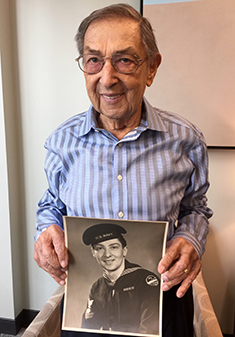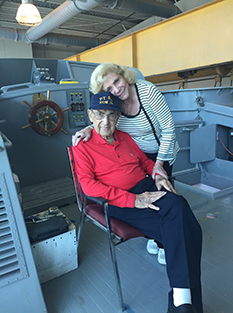The Survivor
By Mary Loftus

At 20, Sol Kaslow was the youngest of the 13-member crew on his PT boat during WWII.
It took Sol Kaslow five decades to talk about being part of the invasion of Normandy as a young navy signalman on a Patrol Torpedo (PT) boat.
"I couldn't handle talking about it," he says. "You live like it just happened."
|
Now 92, Kaslow is healing well after his recent TAVR procedure. "He came through with flying colors, and plans to be on the restored PT-305 when it launches," says his daughter. "Our entire family will get to experience this special moment with him." |
|
|
Sol and Florence Kaslow tour the restored PT-305 boat, scheduled to launch this spring in New Orleans. |
|
Then, for his 80th birthday, he and his wife, Florence, returned with a tour group to Normandy, where Allied Forces landed on the northern coast of occupied France on June 6, 1944, in a well-planned invasion against Germany.
As the tour guide started talking about the assault—which remains the largest amphibious military invasion in history—Kaslow said, "Let me tell it, I was there."
Now 92, Kaslow, the only living member of his PT crew that was in the Normandy invasion, plans to be on the world's only restored PT-305 when it launches in New Orleans this spring.
It's a chance he wouldn't have had without the TAVR heart procedure to address a severe narrowing of his aortic valve.
"My cardiologist said I didn't have long to go, because there wasn't enough blood circulating," says Kaslow, of Palm Beach Gardens, Florida, who had been feeling more tired than normal. "I had no pain, so I wasn't aware of how serious it was. He said I might have a few more years, or I could go at any minute if I didn't have it."
After consulting with cardiologist Vasilis Babaliaros at Emory, Kaslow and his family decided he would undergo a transcatheter aortic valve replacement (TAVR), which is less invasive than open heart surgery. "Aortic stenosis is progressive and relentless," says Babaliaros. "Once you develop symptoms, you are at high risk for sudden death or chronic heart failure, which is often fatal within three years. In the past, the only alternatives for these patients were hospice and palliative care."
"I've had a good life and wanted a few more years if possible," Kaslow says.
"We all recognized that the decision for someone at my dad's age to undergo such a procedure is a complex one. We had a lot of questions about the risks and the benefits," says his daughter, Nadine Kaslow, chief psychologist at Grady Hospital and a professor and vice chair of psychiatry and behavioral sciences at Emory. She knew her dad wouldn't be happy with a sedentary life. "He played tennis until he was 90," she says, "and exercised five times a week, right up until the surgery."
With TAVR, patients do not have to have their chest opened, their heart stopped, or go on a cardiopulmonary bypass machine. Instead, during the procedure a team of cardiologists and cardiac surgeons thread a replacement valve up through an artery in the patient's groin and into place in his heart. The technique allows patients to recover more quickly with less complications
Originally used to treat only those patients deemed high risk, TAVR has proven to be an effective treatment for intermediate-risk patients and is in clinical trials with low-risk patients. Emory has performed 2,000 TAVR procedures, more than anywhere else in the Southeast. Babaliaros trained in France with Alain Cribier, the founder of TAVR, and is a protégé of Emory cardiologist Peter Block, a pioneer in structural intervention.
"We continue to push the boundaries, finding ways to help those who have been turned away elsewhere," Babaliaros says.








